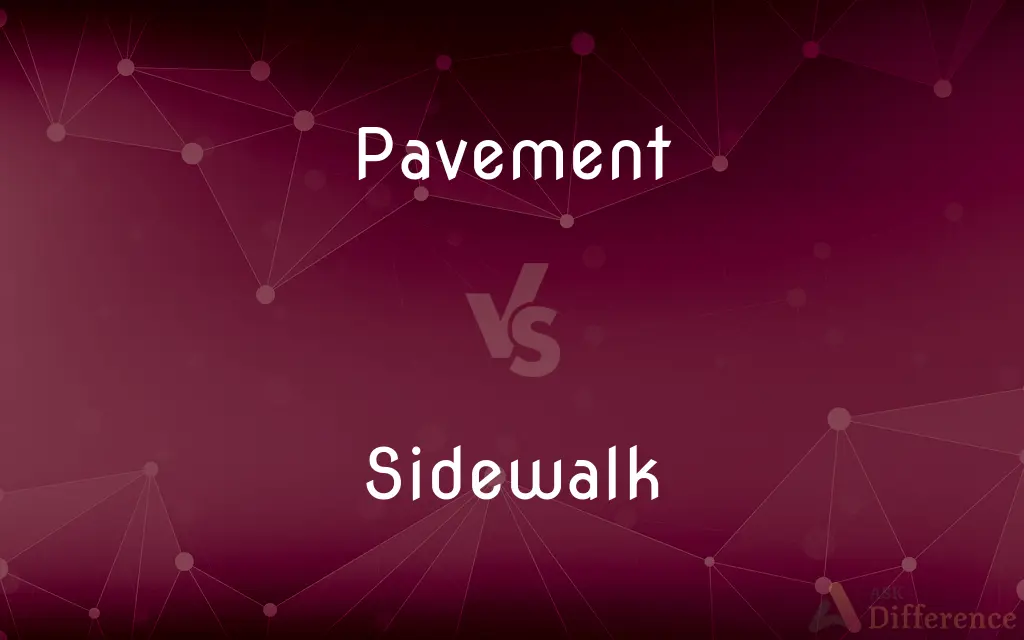Pavement vs. Sidewalk — What's the Difference?
Edited by Tayyaba Rehman — By Fiza Rafique — Updated on March 6, 2024
Pavement refers to the hard surface of roads or streets. Sidewalk is a path for pedestrians on the side of a street.

Difference Between Pavement and Sidewalk
Table of Contents
ADVERTISEMENT
Key Differences
Pavement is a term broadly used to describe the hard, durable surface laid on the ground to create roads, streets, or pathways that support vehicular or foot traffic. It encompasses various materials including asphalt, concrete, cobblestone, and more, designed to withstand the wear and tear of daily traffic. Sidewalk, on the other hand, specifically refers to a paved path designated for pedestrian use, typically found alongside urban streets and roads. Sidewalks are constructed to ensure the safety of pedestrians, allowing them to walk separate from and parallel to vehicular traffic. They are an essential component of urban infrastructure, promoting walkability and accessibility within communities.
The primary purpose of pavement is to provide a smooth, stable, and durable surface for vehicles, facilitating transportation and movement within an area. Sidewalks may be made from concrete, bricks, tiles, or other materials, focusing on providing a safe and comfortable walking surface.
The key difference between pavement and sidewalk lies in their intended use and location. Pavement is a general term for any hard-surfaced path or road designed primarily for vehicles, although it can also accommodate pedestrians in some contexts, especially in British English where "pavement" can refer to what Americans call a sidewalk. Sidewalks are specifically designed for pedestrian traffic, ensuring a safe space for walking away from vehicles.
While pavements are integral to the overall road infrastructure supporting various types of traffic, sidewalks are crucial for pedestrian mobility, safety, and the social aspect of urban design, encouraging walking as a mode of transportation. Pavements need to be designed to withstand heavier loads and more rigorous wear, whereas sidewalks are tailored to pedestrian needs, often incorporating elements like curb cuts, benches, and street lamps to enhance the walking experience.
While both pavements and sidewalks serve as pathways for movement, their design, purpose, and users distinctly differ, highlighting the importance of both in facilitating efficient and safe transportation within urban environments.
ADVERTISEMENT
Comparison Chart
Definition
Hard surface of roads and streets for vehicular traffic.
Path designed specifically for pedestrians, usually alongside a street.
Primary Use
Supports vehicles, bicycles, and foot traffic.
Exclusively for pedestrian use.
Location
Covers the driving portion of roads and streets.
Located on the sides of urban streets and roads.
Materials
Asphalt, concrete, cobblestone, etc.
Concrete, bricks, tiles, and similar materials.
Purpose
To facilitate transportation and movement of vehicles.
To provide a safe and accessible path for pedestrians.
Compare with Definitions
Pavement
In British English, also refers to what Americans call a sidewalk.
Be sure to walk on the pavement and stay off the road.
Sidewalk
Designed for safe pedestrian traffic away from vehicles.
The wide sidewalks in the city center encourage people to walk more.
Pavement
The constructed layer of a road designed to bear the load of traffic.
Heavy trucks cause more wear and tear on the pavement.
Sidewalk
Includes features for accessibility, like curb cuts.
The sidewalk ramps make the city more accessible to people in wheelchairs.
Pavement
A term that encompasses various road surfaces.
Cobblestone pavements add historical charm to the old town.
Sidewalk
A pedestrian path adjacent to a street.
The children played hopscotch on the sidewalk.
Pavement
The durable surface material of roads designed for vehicle traffic.
The city repaved the cracked pavement to improve road safety.
Sidewalk
Often made of concrete or similar materials for durability.
The newly laid concrete sidewalk improved neighborhood walkability.
Pavement
A general term for any hard-surfaced ground covering.
The new parking lot was covered with fresh asphalt pavement.
Sidewalk
An essential element of urban planning for pedestrian safety.
The expansion project includes adding sidewalks to all major roads.
Pavement
A hard smooth surface, especially of a public area or thoroughfare, that will bear travel.
Sidewalk
A sidewalk (North American English), pavement (British English), footpath (Oceanian English), or footway, is a path along the side of a road. Usually constructed of concrete or asphalt, it is designed for pedestrians.
Pavement
The material with which such a surface is made.
Sidewalk
A paved walkway along the side of a street.
Pavement
A paved surface; a hard covering on the ground.
Sidewalk
(US) (usually) a paved footpath located at the side of a road, for the use of pedestrians
Pavement
A paved path, for the use of pedestrians, located at the side of a road.
Sidewalk
Any paved footpath, even if not located at the side of a road
Pavement
A paving (paved part) of a road or other thoroughfare; the roadway or road surface.
Sidewalk
A walk for foot passengers at the side of a street or road; a foot pavement.
Pavement
The paved part of an area other than a road or sidewalk, such as a cobblestone plaza, asphalt schoolyard or playground, or parking lot.
Sidewalk
Walk consisting of a paved area for pedestrians; usually beside a street or roadway
Pavement
That with which anything is paved; a floor or covering of solid material, laid so as to make a hard and convenient surface for travel; a paved road or sidewalk; a decorative interior floor of tiles or colored bricks.
The riches of heaven's pavement, trodden gold.
Pavement
Walk consisting of a paved area for pedestrians; usually beside a street or roadway
Common Curiosities
What's the main difference between pavement and sidewalk?
Pavement refers to the hard surface of roads for vehicular traffic, while a sidewalk is a designated pedestrian path alongside a road.
Why are sidewalks important in urban areas?
Sidewalks are crucial for pedestrian safety, promoting walkability and accessibility by providing a dedicated space for walking away from vehicular traffic.
How do pavements and sidewalks contribute to transportation?
Pavements facilitate vehicular movement and transportation efficiency, while sidewalks ensure pedestrian safety and mobility, together supporting comprehensive urban transportation networks.
Is the construction of pavements and sidewalks significantly different?
Yes, pavements are designed to withstand heavier loads and include layers for durability, whereas sidewalks focus on pedestrian safety and may include features like ramps for accessibility.
Can sidewalks be found in rural areas?
While more common in urban and suburban areas, sidewalks can also be found in rural areas near schools, parks, or community centers to enhance pedestrian safety.
What materials are used for sidewalks?
Sidewalks are typically made from concrete, bricks, or tiles, chosen for their durability and pedestrian comfort.
How do weather conditions affect the maintenance of pavements and sidewalks?
Weather conditions like rain, snow, and temperature fluctuations can cause wear and damage to both pavements and sidewalks, necessitating regular maintenance and repair to keep them in good condition.
Can the term pavement refer to sidewalks?
Yes, in British English, "pavement" commonly refers to what Americans call a sidewalk.
Are there regulations governing sidewalk construction?
Yes, there are typically local and national standards and regulations that govern the construction, maintenance, and accessibility of sidewalks to ensure they are safe and accessible for all pedestrians.
How does the presence of sidewalks affect a community?
Sidewalks positively impact a community by enhancing pedestrian safety, encouraging walking, and contributing to the overall health and social interaction within the community.
Share Your Discovery

Previous Comparison
Job vs. Task
Next Comparison
Amusing vs. AmusedAuthor Spotlight
Written by
Fiza RafiqueFiza Rafique is a skilled content writer at AskDifference.com, where she meticulously refines and enhances written pieces. Drawing from her vast editorial expertise, Fiza ensures clarity, accuracy, and precision in every article. Passionate about language, she continually seeks to elevate the quality of content for readers worldwide.
Edited by
Tayyaba RehmanTayyaba Rehman is a distinguished writer, currently serving as a primary contributor to askdifference.com. As a researcher in semantics and etymology, Tayyaba's passion for the complexity of languages and their distinctions has found a perfect home on the platform. Tayyaba delves into the intricacies of language, distinguishing between commonly confused words and phrases, thereby providing clarity for readers worldwide.














































